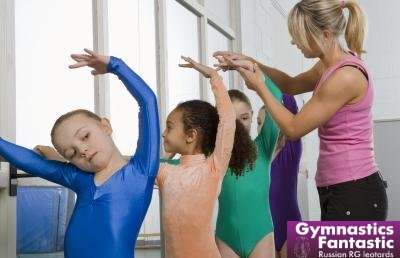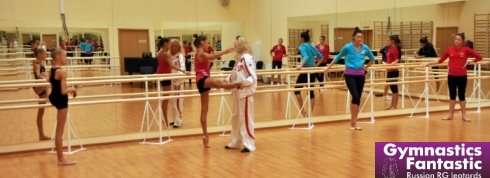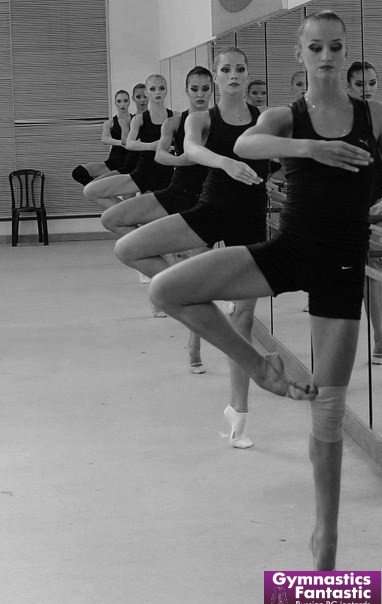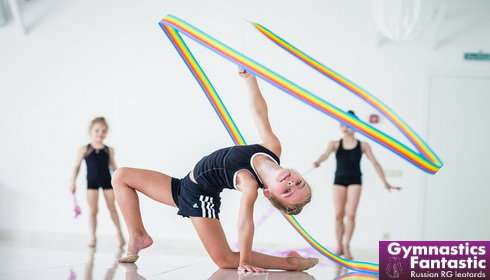Why ballet is important for Rhythmic Gymnastics
Ballet is the basic thing in Rhythmic Gymnastics. Daily choreography exercises are necessary for a gymnast so that she could feel her body, develop the upright posture, arms and foot positions, which are the basic for all the rhythmic gymnastics elements. So when the gymnast standing near the ballet bar starts feeling the positions she stands, jumps and turns through the basic elements such as battement tondu, jete, fondu, means she starts feeling her body, which allows her to do more complicated elements and understand her mistakes.
Classical ballet gives the feeling of the movement’s completion. It means you should feel muscle tension from the shoulder blade to the finger tips when you sway your arm. Rising in releve gymnast should feel her body tension from the tip toes to the top of her head through all the muscles: ball of foot, knees, hips, pelvis, belly, shoulder blade, neck, shoulders, arms and head. Thus, gymnast can take any beautiful position without a moment’s hesitation only if she has devoted great amount of time to choreography lessons.
Inborn abilities are not the recipe for success. Even if a gymnast is very flexible and stretched, it doesn’t allow her to do complex ballet elements without any mistakes. Sure, these girls can easier rise their legs thank to soft joints and stretched muscles. But they should control their body and muscles in order to do quick movements, jumps and battements, hold the legs in balance without the help of arms; and this can be achieved only through the ballet.

When gymnast comes into the carpet it could be clearly seen how she is prepared in terms of choreography: how she raises her arms, throws her legs in jumps. The right position should be taken at the top point of the jump, this also can be achieved only at choreography lessons. If a gymnast doesn’t go in for choreography, it easily can be noticed as her movements lack beauty and coordination. For example, if a gymnast is doing rotation, she should grab her foot with her hand, rise in releve and reverse the heel in the concrete moment and in addition to this she should feel her shoulder turn. Only complete body control and allows a gymnast to take the right position, feeling every muscle, and do good rotation. Only in this case the success is in her pocket and she becomes confident that she’ll always do this element even with the apparatus. Moreover, apparatus, whether it is a ball or a hoop, gives an additional force in rotation, gymnast should bear it in mind and feel when she should draw it away. So the right posture trained at choreography lessons helps gymnast not only to do various elements, but also to feel how to work with apparatus doing these elements.

More than that, choreography means not only ballet, but folk and other dance styles. Girls are taught improvisation, so that they can dance on the go, this skill helps them to move from one element to another through the dance and to feel the rhythm (dance to the music). Rhythmic Gymnastics Judgment Rules include scores for artistry – harmonic body movements to the music. That’s why it’s necessary to fall in time at choreography lessons. Movements and elements learnt at choreography lessons can be used in exercises with apparatus. Some gymnasts start improvising on the base of the movements they know, and that drags them into the process of exercise preparation. In this case, coach, choreographer and gymnast work together, such cooperation leads to the best results.

Today, when gymnasts do the most complicated elements on strength and flexibility, choreography has also changed. Now work at the ballet bar and in the middle of the dance room has to include gymnastics elements beside the classical ballet. When choreographer sees what elements are not easy for gymnasts, he/she includes them in choreography basic exercises at the bar and in the middle. Now choreography lesson at the bar teaches not only to control the body, but to do complicated elements on the carpet.
Working at the bar it’s important to work out the feet and try to do exercises at quick tempo. Quick technique influences on jumps and other elements.

While gymnast is working at the bar combining classical ballet and gymnastics elements, for example, adagio, she can turn to the wall, linger, load the foot, do element on the front balance, turn. Thus she combines classical movements, which don’t allow the body to relax and help to dance, and gymnastics movements, which will be done on the carpet in future. Very often choreographer may teach choreography in the middle with the apparatus. For example, if you take a ball you can do padebure with ‘eight”, plie with rolling etc. thus gymnast can learn to control her body and use apparatus at the same time.
Such jumps as eshape, assamble, gabriole, kazachok with a 90 degrees balance stop etc. are necessary to strengthen the feet, they help to develop the right landing through the balls of feet. Only then you should do high jumps. Otherwise, gymnast may have problems with knees and feet.
When explaining the elements choreographer shares his/her experience, he/she knows how every muscle should work and can explain it rightly. Ballet classes give your body beauty and health, teaches how to dance to music and prepares physically for complicated gymnastics elements.
Tips
1. It’s important to come to the ballet classes in comfortable tight clothes with the hair done, so that fringe couldn’t bother you in motion. Thus a gymnast feels like a small ballerina and takes choreography lessons seriously
2. It’s not recommended to eat much before the classes, otherwise gymnast feel heavy and can’t train easily. It’s better to eat 2 hours before the classes.
01 Sep 2016 at 06:00
01 Sep 2016 at 06:00
01 Sep 2016 at 06:00
Like it? Tell your friends
















